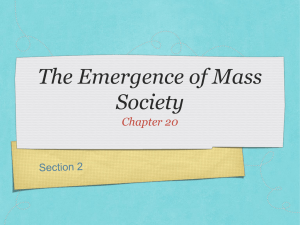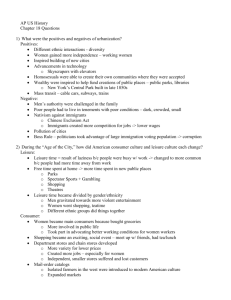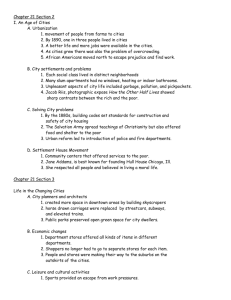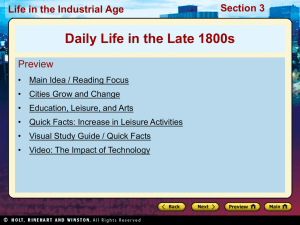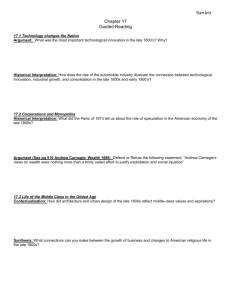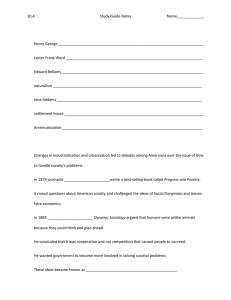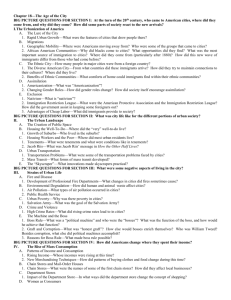AHON_ch18_S3 - Epiphany Catholic School
advertisement
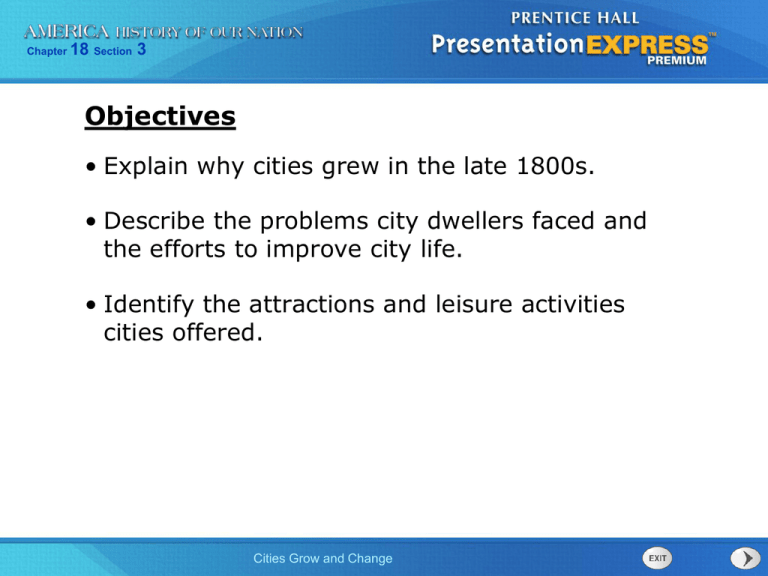
Chapter 18 Section 3 Objectives • Explain why cities grew in the late 1800s. • Describe the problems city dwellers faced and the efforts to improve city life. • Identify the attractions and leisure activities cities offered. Cities Grow and Change Chapter 18 Section 3 Terms and People • urbanization – the rapid growth of city populations • tenement – building divided into many tiny apartments • Jane Addams – reformer who worked to help poor city dwellers • settlement house – center offering help to the urban poor Cities Grow and Change Chapter 18 Section 3 What were the causes and effects of the rapid growth of cities? During the late 1800s, cities were places of excitement, new ideas, and entertainment. For the urban poor, however, they were also places of misery. Cities Grow and Change Chapter 18 Section 3 The new Industrial Revolution was a time of frenzied growth—for businesses, factories, and cities. City populations soared as many people left farm life behind. Cities Grow and Change Chapter 18 Section 3 Many fast-growing cities were located near waterways because they provided an easy way to transport goods. Cities Grow and Change Chapter 18 Section 3 New technology supported rapid urbanization. Changing technology led to dramatic improvements in public transportation. • Elevated trains Urban transportation • Electric streetcars • Subways • Steel bridges Cities Grow and Change Chapter 18 Section 3 Public transportation encouraged cities to expand outward and allowed people to commute from the suburbs. Cities Grow and Change Chapter 18 Section 3 New technology, like elevators, helped cities expand upward, as well. Skyscrapers soon towered over city skylines. Cities Grow and Change Chapter 18 Section 3 Most of the people moving to cities were looking for jobs. All types of people, including farmers, immigrants, and African Americans from the South, came to work in the cities. Farmers Immigrants City African Americans Cities Grow and Change Chapter 18 Section 3 Fast growth, however, created many problems. Life in city tenements was dismal. Often, people crowded together in a single room with no windows, heat, or plumbing. Cities Grow and Change Chapter 18 Section 3 Life in some cities could be dangerous—even deadly. Overcrowding Garbage Urban problems Fire Disease A fire broke out in Chicago in 1871 and left 18,000 homeless. Babies were especially at risk and often died before they reached their first birthday. Cities Grow and Change Chapter 18 Section 3 In the 1880s, cities began to make changes to improve urban life. Cities Grow and Change Chapter 18 Section 3 Religious leaders and reformers like Jane Addams also worked to help the urban poor. Reformers Helped the homeless Opened settlement houses Worked to outlaw child labor Cities Grow and Change Set up hospitals and clinics Chapter 18 Section 3 Despite their problems, cities offered many benefits. One of the biggest attractions was shopping. Elegant new department stores offered many different goods under one roof. Cities Grow and Change Chapter 18 Section 3 Also, professional sports teams began to form in cities. Basketball was invented in 1891 and it quickly became a popular winter sport. Baseball was the most popular sport, with games attracting thousands of fans. Football was also popular, although it was very dangerous. Cities Grow and Change Chapter 18 Section 3 As the division between work and play became stricter, cities began to provide a wide variety of entertainment and leisure activities. Museums Theaters Zoos Orchestras Parks These places of leisure allowed city dwellers to enjoy art, performances, green grass, and cleaner air. Cities Grow and Change Chapter 18 Section 3 Section Review QuickTake Quiz Cities Grow and Change Know It, Show It Quiz



